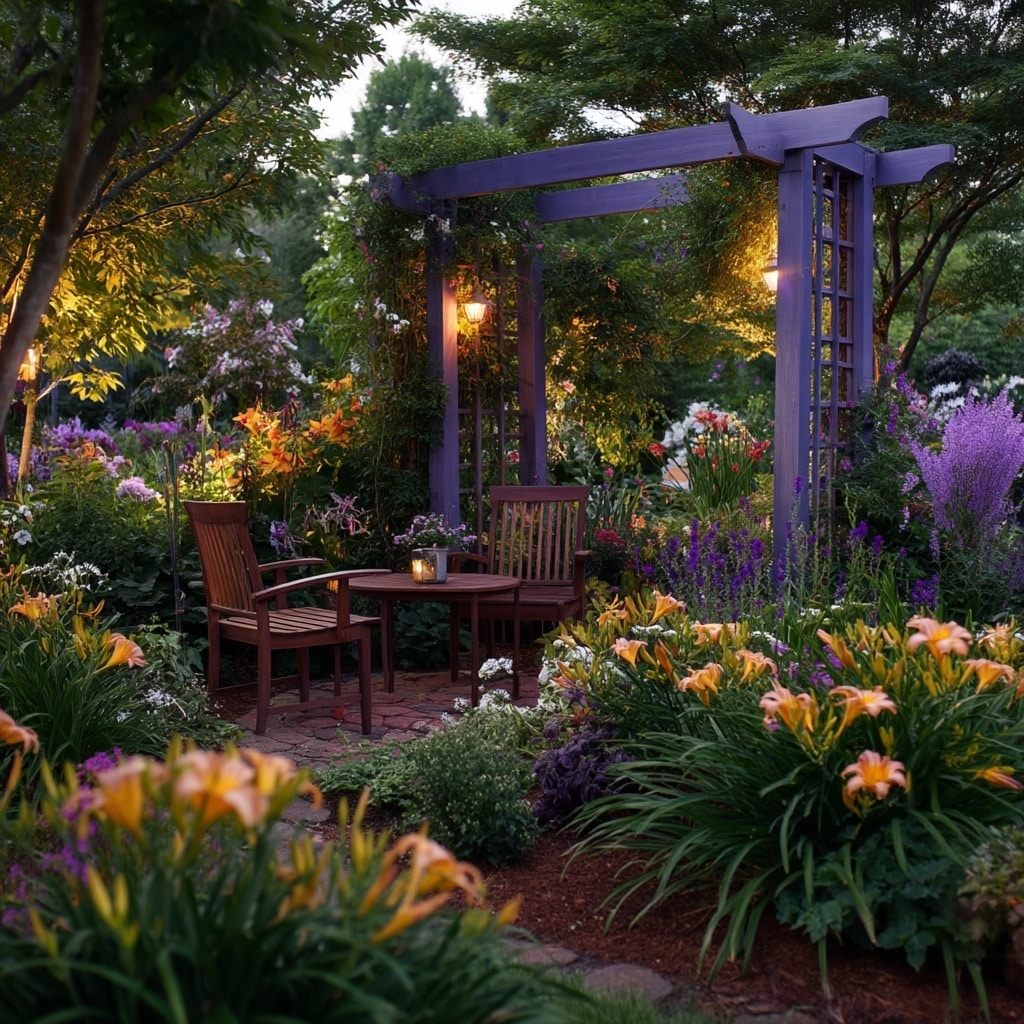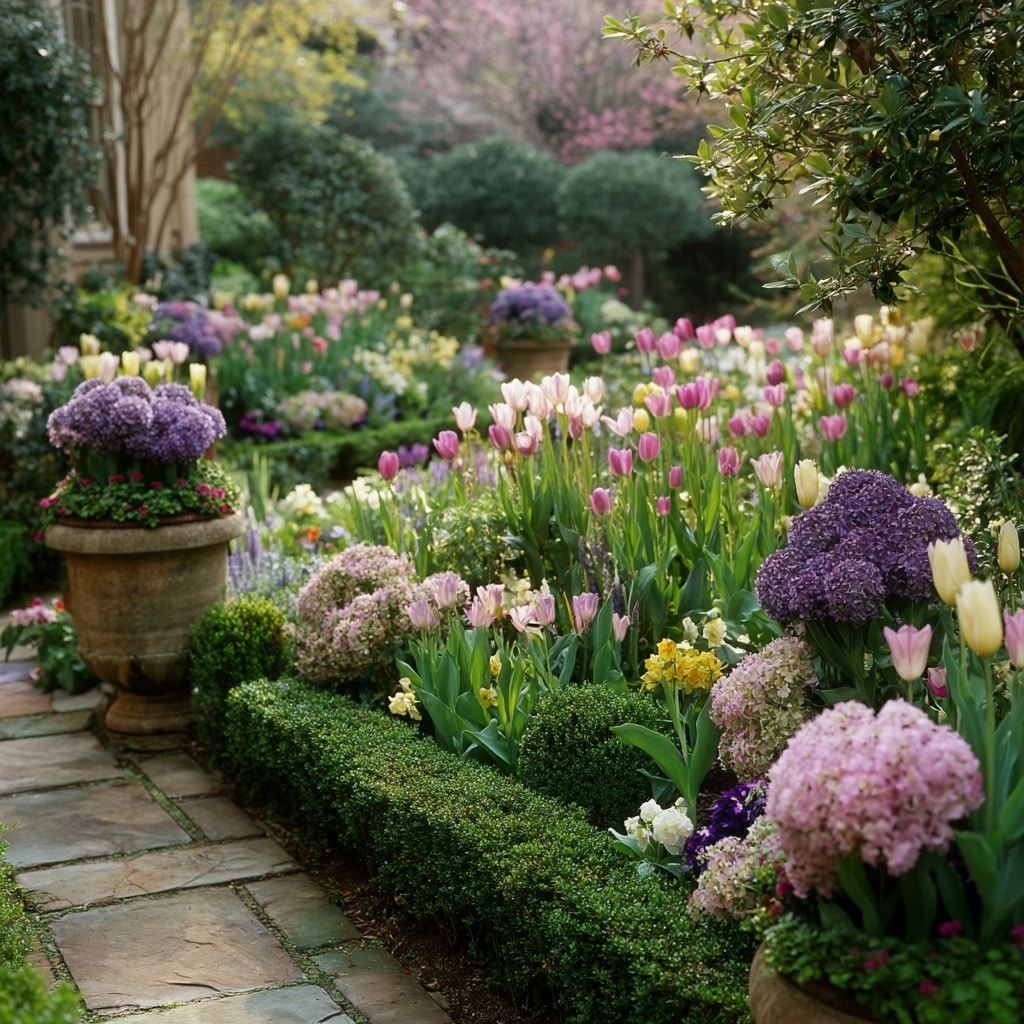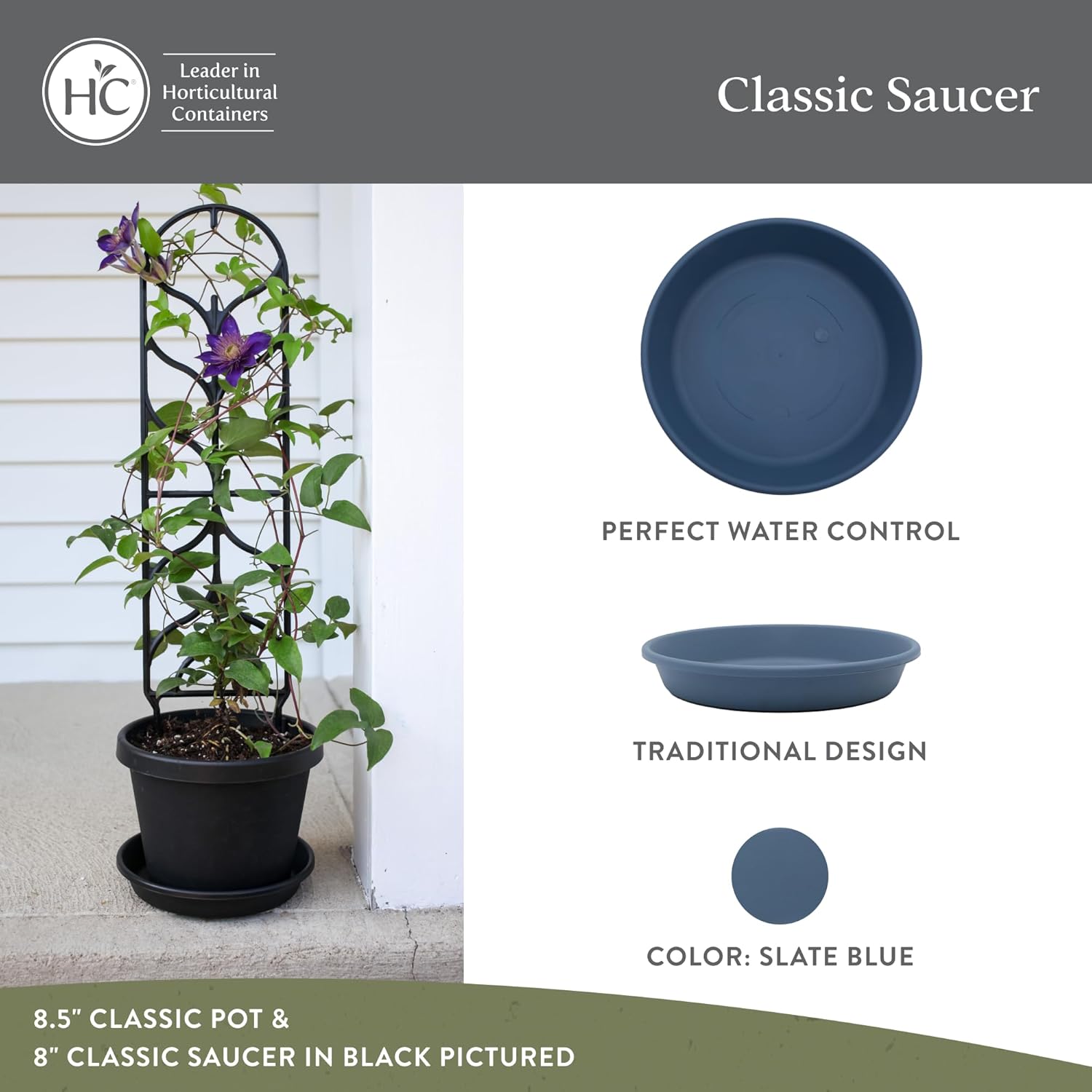Garden ideas can turn even the simplest outdoor space into a vibrant, personal sanctuary filled with color, texture, and seasonal interest. Whether you’re starting from a bare patch of grass or revamping a tired corner, a thoughtfully designed flower garden adds character and charm to any landscape. From curved borders and bold color groupings to restful nooks surrounded by blooms, creative planting combinations can elevate your garden into something truly special. This guide brings together stunning flower garden ideas that work beautifully in both front and backyard settings.
Table of Contents
Spring Flower Garden Ideas
Spring is the perfect time to bring fresh life and color into your landscape with thoughtful garden ideas. Focus on plants that burst into bloom early and set the tone for the rest of the growing season.
Use Waves of Color
Instead of scattering plants randomly, group flowers in waves or clusters. For example, plant pink and yellow tulips in flowing lines for a dynamic and cohesive look. Mass planting creates greater impact than single blooms spaced far apart.
Combine In-Ground and Container Plants
You don’t need to limit yourself to flowerbeds. Use containers to introduce height and variety. Potted hydrangeas can be moved around to highlight different garden zones, and they provide excellent color that lasts well into summer.
Add Structure with Evergreens or Shrubs
To prevent your flower garden from looking flat, add evergreen shrubs like boxwood in short rows or clusters. These provide year-round structure and visual relief between masses of flowers.
Include Pastel Tones for a Soft Look
Spring lends itself well to soft color palettes. Think pale pinks, buttery yellows, light lavender, and soft blues. These colors blend harmoniously and bring a calming feel to your garden design.
Flower Garden Ideas with Curves and Shapes
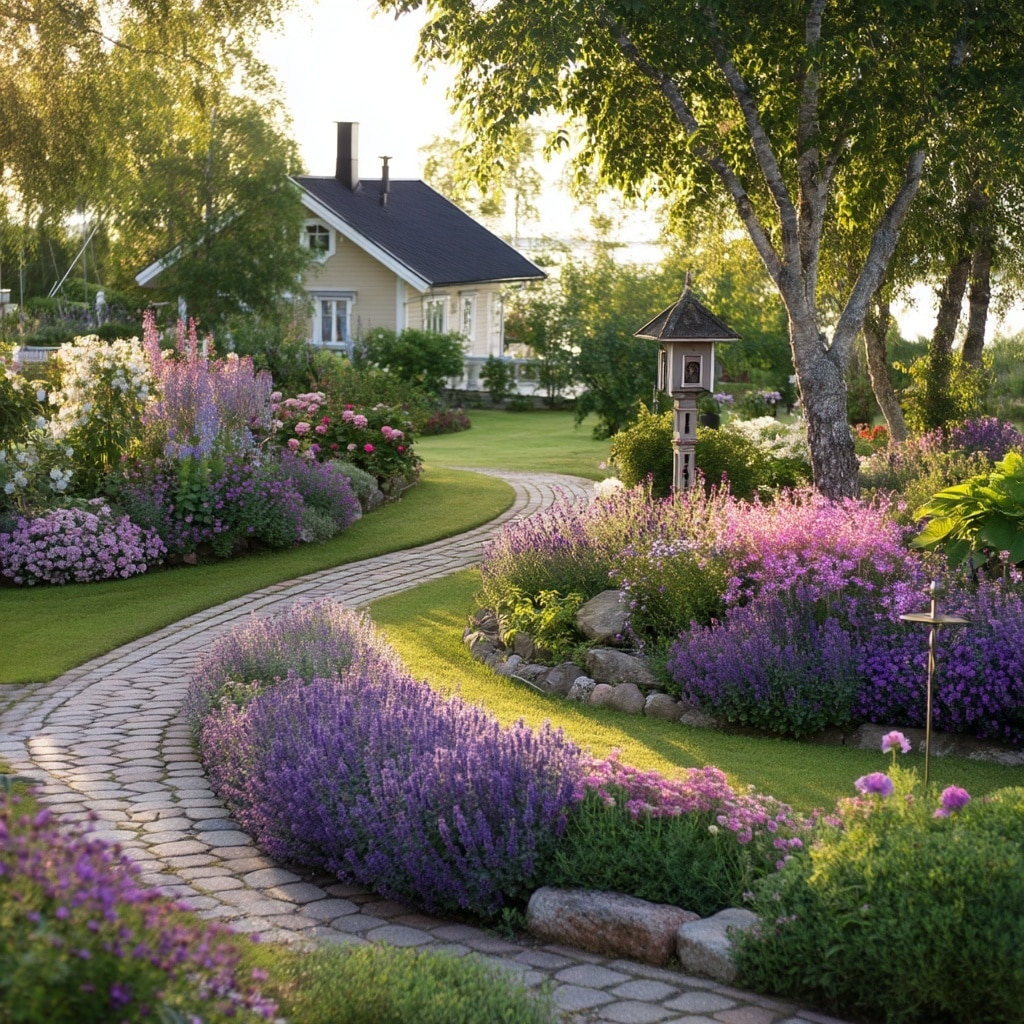
Adding shape to your flower beds doesn’t just enhance visual appeal—it helps guide the eye and organize space naturally. Curved lines and thoughtful forms make even simple garden ideas look professionally designed.
Design with Soft, Curved Edges
Replace rigid, straight lines with gently flowing curves to create a sense of movement. Curved flower beds mimic natural landscapes and feel more welcoming, especially in larger lawns or open backyard spaces.
Repeat Colors for Harmony
Plant flowers in coordinated hues—such as lavender, plum, and fuchsia—to create a soothing, cohesive look. When these tones are planted in curved beds, they feel even more connected and balanced.
Add Hardscape for Contrast
Use circular paving stones or curved gravel paths to enhance your garden’s shape. The contrast between soft plants and firm surfaces creates a balanced design that’s easy to walk through and maintain.
Include Decorative Structures
A whimsical birdhouse or a tall trellis can become a visual anchor. These structural pieces work beautifully in curvy gardens by adding height and character, especially when surrounded by soft mounding plants.
Grouping and Layering Plants for Impact
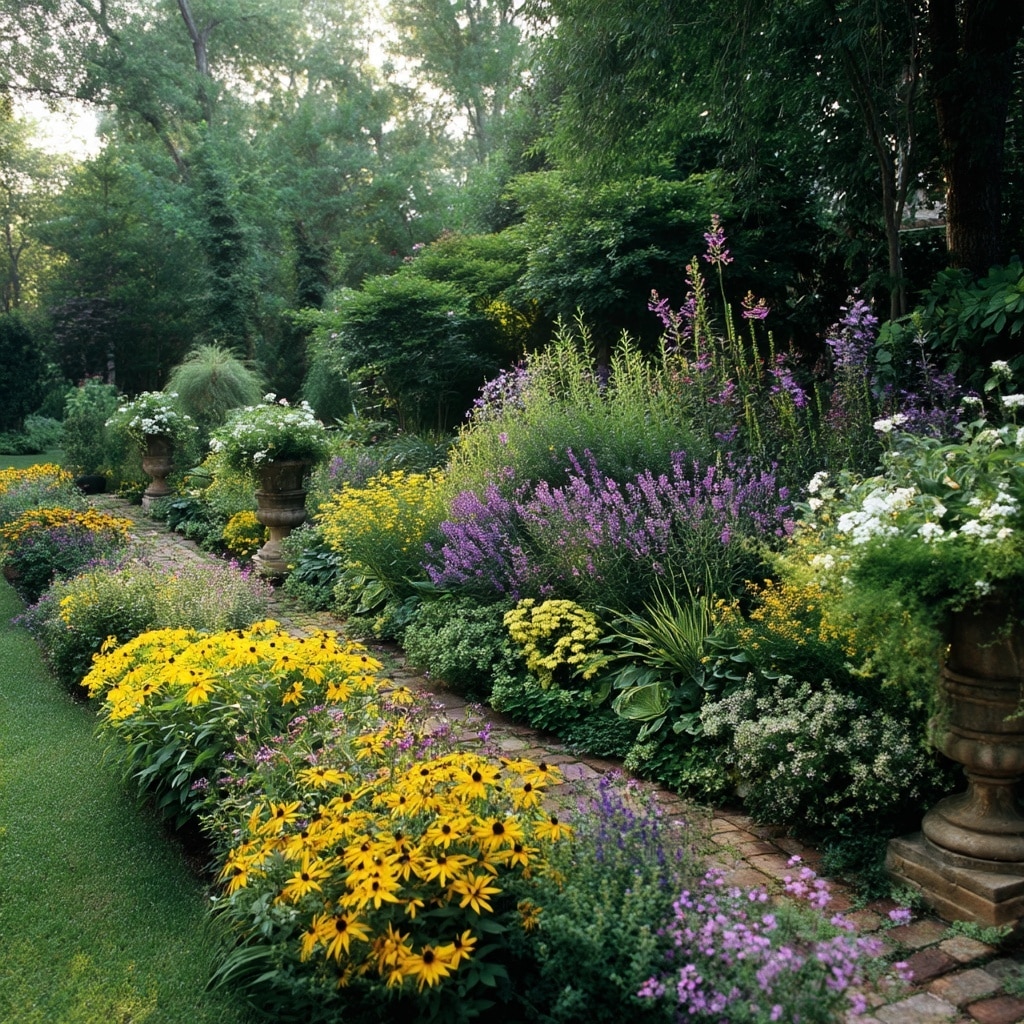
One of the most effective garden ideas for creating visual depth and balance is to group and layer your plants strategically. By organizing flowers in thoughtful patterns, you can make any space look fuller, more intentional, and much more attractive.
Follow the Rule of Three
Planting in odd numbers—especially in groups of three—creates a more natural and pleasing rhythm. Try clustering three of the same flower species, like black-eyed Susans or coneflowers, to build visual harmony and avoid a scattered look.
Use Vertical Interest
Add height by placing taller plants, such as meadow rue or salvia, toward the back of the bed. These vertical elements give structure and allow lower-growing varieties to shine in the foreground.
Transition with Low-Growing Plants
Plants like catmint or creeping thyme soften the edges of flowerbeds and pathways. They act as a gentle buffer between hard surfaces and taller blooms, enhancing the flow of your garden layout.
Include Statement Pieces
Use decorative objects like urns, stone statues, or small trellises as transitions between different plant groupings. These features can anchor your design and offer visual breaks without disrupting the plant flow.
Creating Relaxing Garden Spaces with Flowers
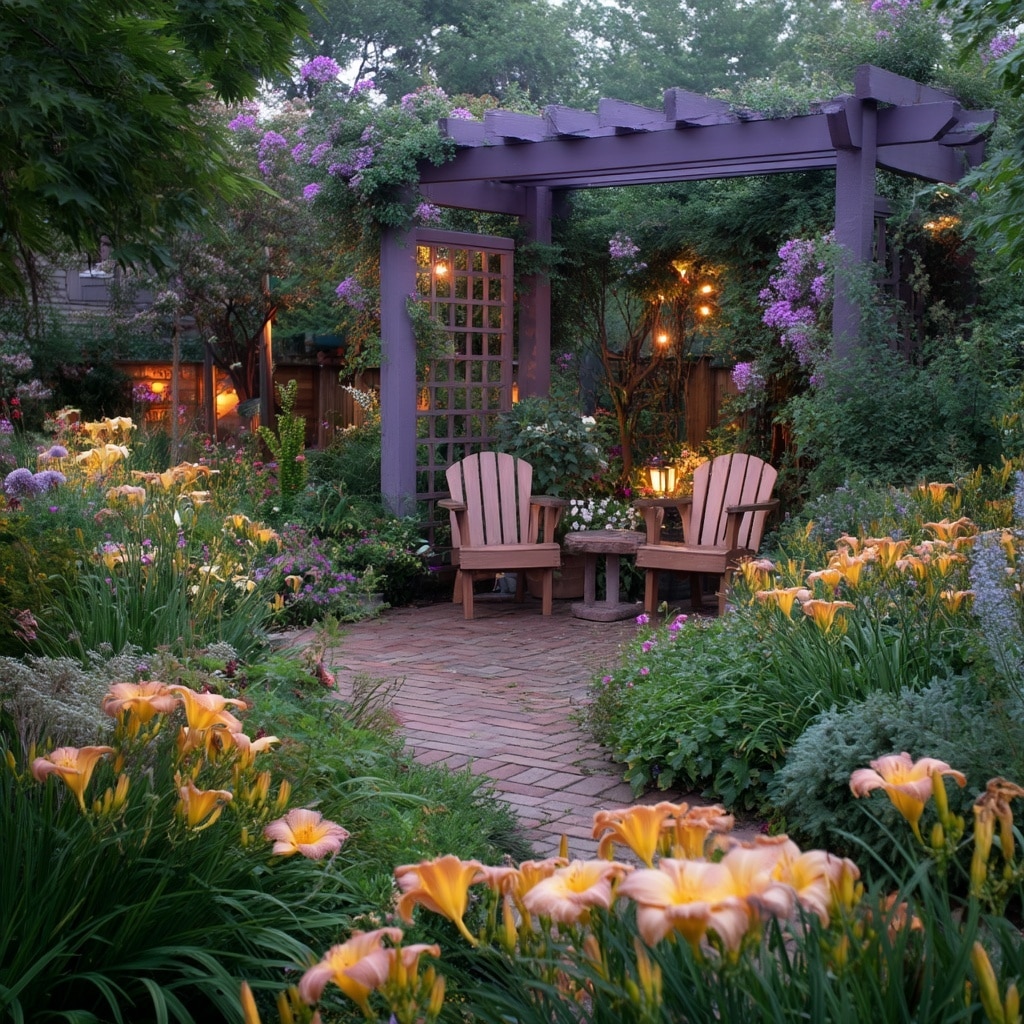
When brainstorming garden ideas for your landscape, don’t just focus on plants—think about how the space makes you feel. A well-designed flower garden can become your personal retreat, blending beauty with comfort.
Surround Seating with Blooms
Position a cozy bench, chair, or small bistro set among flowering beds. Daylilies in pink, white, and yellow make for colorful, welcoming surroundings. Furniture in neutral tones blends naturally into the landscape without competing with the flowers.
Use Trellises and Arbors for Privacy
If trees or shrubs aren’t an option for creating a border, try vertical features like trellises or lattice panels. Covered in vines or climbing flowers, these elements provide privacy and visual interest.
Densely Plant to Reduce Weeds
For lower maintenance and fuller garden beds, plant flowers closer than recommended. Dense planting fills empty space quickly, reducing weed growth and helping soil retain moisture—especially useful in high-traffic areas.
Blend Scent and Sound
Incorporate fragrant flowers like lavender or phlox near seating areas. Add wind chimes or water features to enhance the sensory experience and create a calming atmosphere.
Garden Ideas for Pathways and Borders
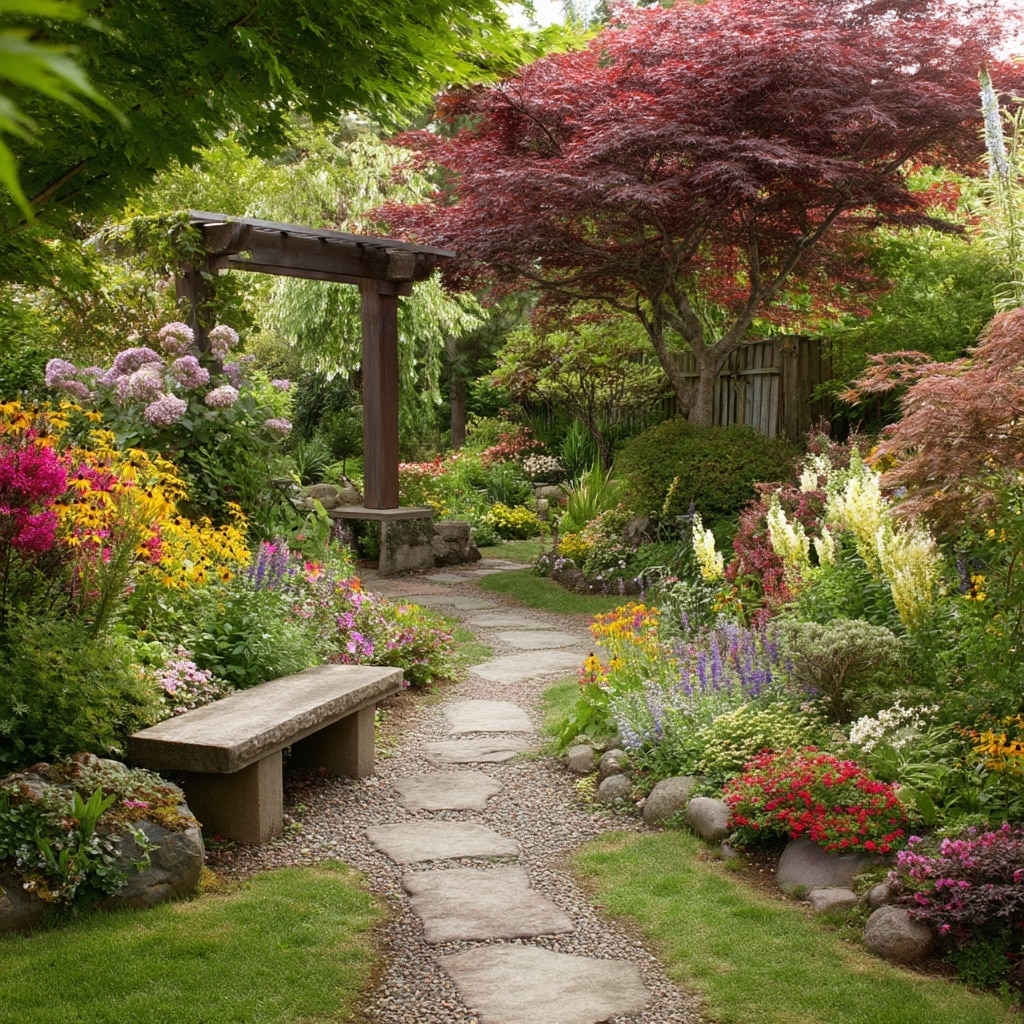
Pathways and borders do more than guide movement—they frame your garden and shape its overall feel. With the right combination of blooms and structure, these garden ideas can elevate your landscape design effortlessly.
Frame Paths with Flowering Edges
Line walkways with cheerful, low-maintenance flowers like black-eyed Susans, petunias, or marigolds. These add bursts of color and soften the lines of your paths without overwhelming the space.
Incorporate a Garden Bench or Pergola
A small bench under a pergola makes a welcoming stop along a winding path. Surround the area with colorful blooms and foliage for a storybook feel. Try combining annuals with shrubs for year-round interest.
Use a Mix of Annuals and Perennials
Borders benefit from a combination of steady perennials and fast-growing annuals that fill in gaps. This balance ensures that your borders stay lush throughout the growing season with little downtime.
Add a Tree for Vertical Interest
Planting a small ornamental tree like a Japanese maple within or near your flower border adds structure and shade. Its seasonal foliage can enhance the color palette of nearby flowers.
Vertical and Side Yard Flower Garden Ideas
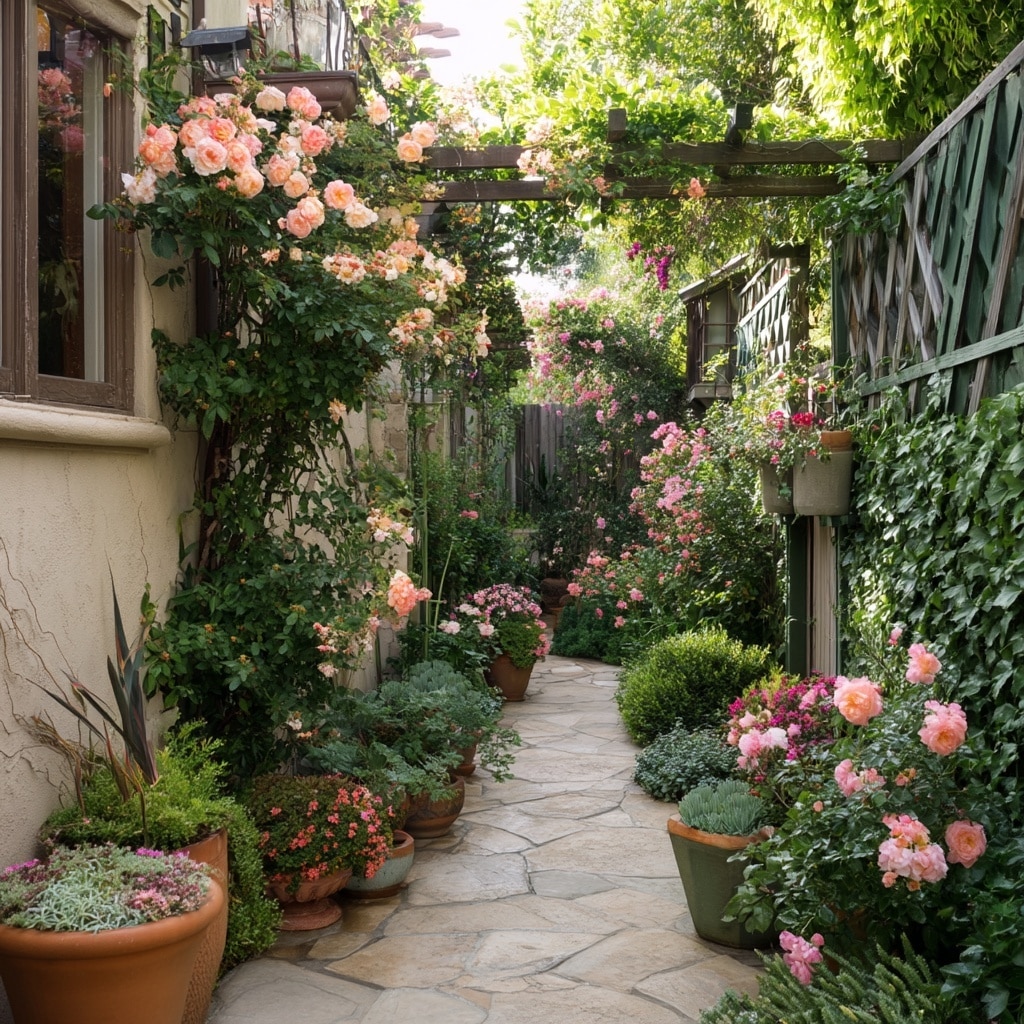
If space is tight, vertical and side yard garden ideas can help you maximize every inch without sacrificing beauty. Whether you’re dealing with narrow pathways or bare walls, there are creative ways to add life and color.
Go Up with Climbing Flowers
Install trellises, tuteurs, or wall-mounted grids to support climbers like roses, clematis, or jasmine. These vertical accents turn plain fences and walls into blooming backdrops that draw the eye upward.
Use Moveable Containers
In tight side yards, flexibility is key. Arrange planters with flowering annuals and succulents along the path. Containers are easy to move and adjust, letting you play with sunlight and layout as the seasons change.
Add Focal Points
Even narrow spaces benefit from a visual centerpiece. A small statue, water feature, or a bold-colored planter can anchor the view and bring purpose to the layout.
Match Flower Colors to Surroundings
Coordinate plant colors with the home’s siding or outdoor accents. For example, white hydrangeas or pale pink geraniums contrast beautifully against darker fences or neutral exterior walls.
Sculptural and Minimalist Garden Ideas
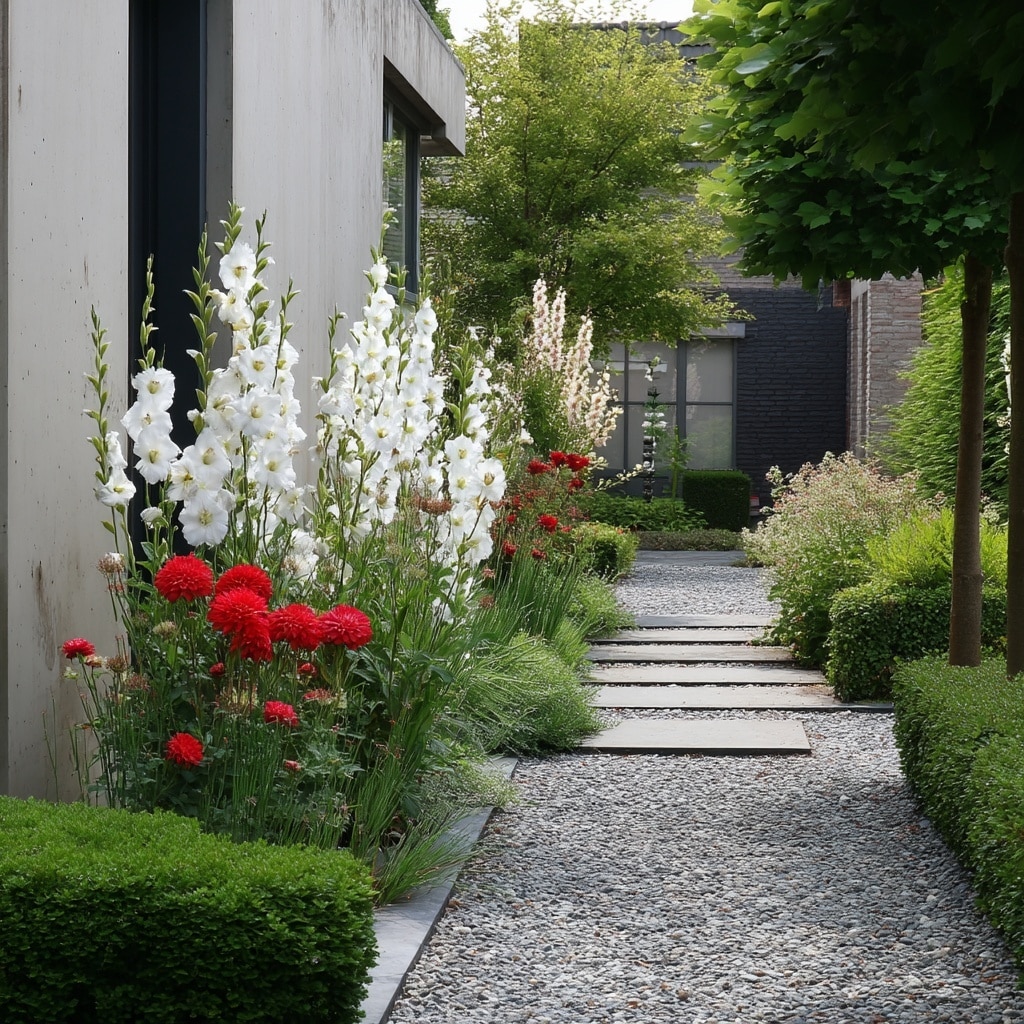
Not every garden needs to be overflowing with blooms. Some of the most striking garden ideas embrace minimalism, structure, and clean design. By focusing on shape, color contrast, and texture, you can create a bold and refined look with fewer elements.
Use Plants with Strong Forms
Choose plants that have defined shapes or sculptural presence—like evergreen pines trimmed into geometric forms or tall, upright gladiolas. These create instant visual structure and work beautifully in minimalist spaces.
Keep the Color Palette Simple
Stick to two or three main colors for a cohesive, elegant result. Try combinations like white gladiolas with red dahlias or purple salvia with silver-leaved lamb’s ear. Limiting the palette reduces visual clutter and emphasizes form.
Add Hardscape to Balance Blooms
Incorporate gravel, stone borders, or paved sections to contrast soft foliage. These clean lines and textures enhance a modern aesthetic and help organize the layout clearly.
Group Plants in Masses
Instead of spreading flowers thinly, cluster the same variety in large swaths. This technique creates drama and makes maintenance easier, especially for those who prefer a low-fuss garden.
Front Yard Flower Garden Ideas
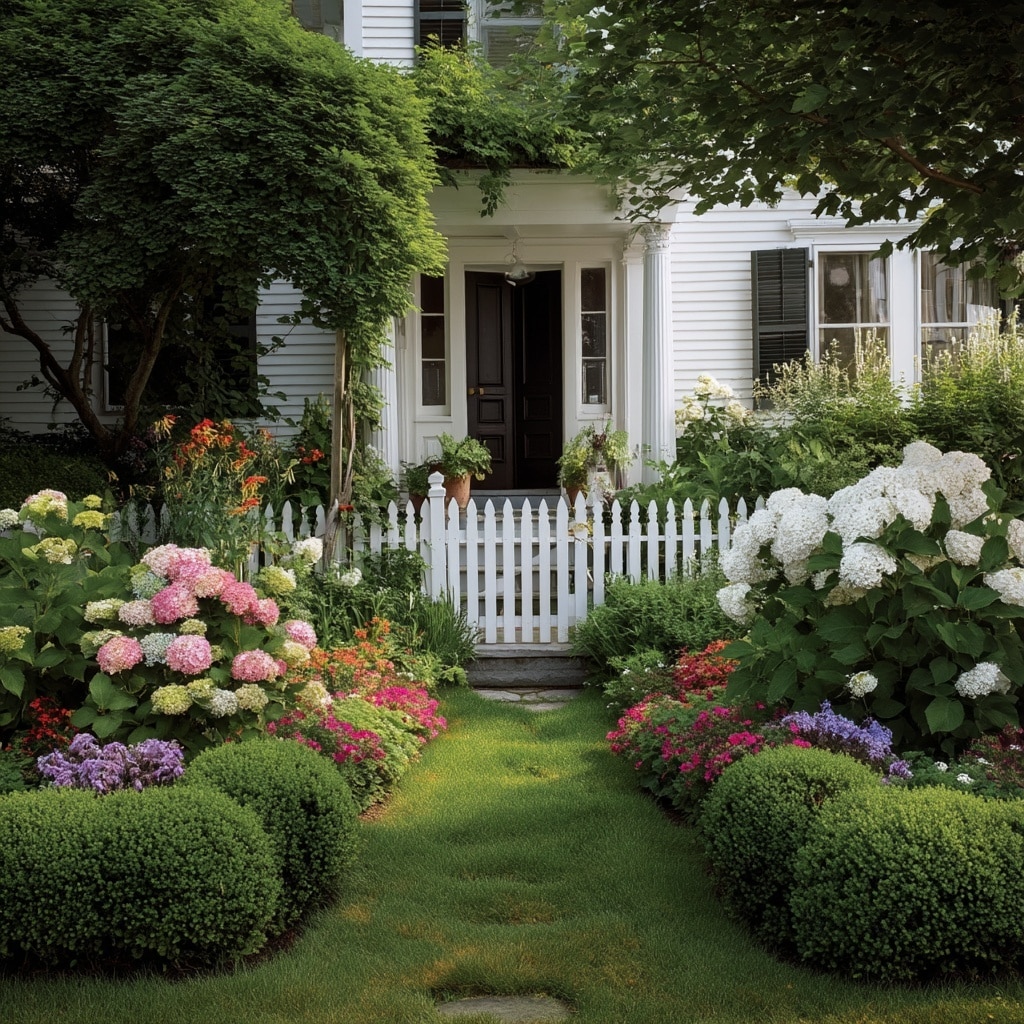
Your front yard sets the tone for your entire home, and well-planned garden ideas can instantly boost curb appeal while creating a welcoming atmosphere. Whether you go bold or classic, flower gardens in the front yard should balance beauty with visibility.
Use Repeating Colors and Plants
Create a polished look by repeating the same plants and color combinations across the garden bed. Endless Summer hydrangeas, astilbe, and daylilies work well in tandem and provide multi-season interest.
Add Low Hedges for Definition
Miniature boxwood hedges or lavender borders help define your flowerbeds and create neat transitions from lawn to garden. They also add structure during seasons when flowers are dormant.
Incorporate Vertical Features
Use trellises or climbing vines near the entryway or porch columns. A white picket fence or an arched trellis can serve as a charming frame for flowering climbers, guiding guests naturally to your front door.
Blend Shrubs and Perennials
Mix low shrubs with flowering perennials to create a layered look. Loosely mounded shrubs offer a backdrop to vibrant blooms while requiring little upkeep.
Whimsical Garden Ideas with Resting Spaces and Wildlife Appeal

If you’re drawn to romantic, nature-inspired garden ideas, consider designs that invite both people and wildlife to linger. Adding whimsical touches and habitat-friendly plants can turn your garden into a haven full of movement, color, and charm.
Create Quiet Seating Areas
Place a stone bench or rustic wooden seat under a pergola or near a small water feature. Nestle it among flowering plants like phlox, coreopsis, and coneflowers for a peaceful spot to relax and reflect.
Encourage Birds and Butterflies
Plant native flowers that attract pollinators—echinacea, butterfly bush, bee balm, and feather reed grass are excellent choices. Include a small pond, birdbath, or shallow fountain for added appeal.
Use Rock Pathways for a Natural Feel
A pathway edged with river rocks or stepping stones adds a sense of journey through the garden. Let it meander and split, leading to hidden corners or tucked-away seating for an enchanting atmosphere.
Mix Textures and Heights
Layer soft, trailing plants with tall grasses and flowering spikes to create a wild, natural rhythm. Let your planting feel loose and slightly unpredictable—it’s all part of the whimsical charm.
Conclusion
From structured flowerbeds to wild, whimsical retreats, these garden ideas show that every landscape has the potential to bloom with beauty and purpose. Whether you’re shaping the curves of a border, creating a peaceful nook, or adding color to your front yard, the right combination of plants and design can transform any space. Focus on what brings you joy—layer your favorites, attract pollinators, and don’t be afraid to experiment. Your garden is more than just a space—it’s a living expression of your style.

